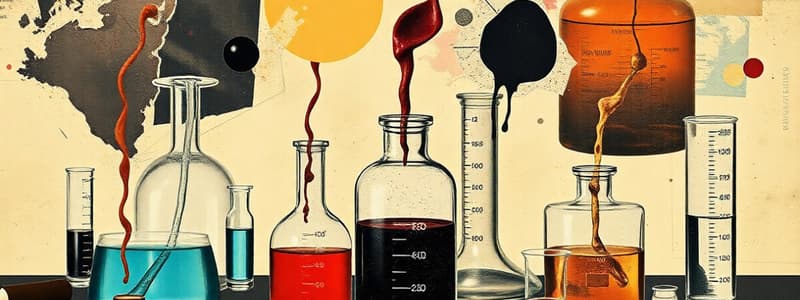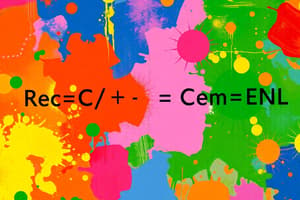Podcast
Questions and Answers
The term "ore" refers to minerals from which metals are typically extracted.
The term "ore" refers to minerals from which metals are typically extracted.
True (A)
The first step in extracting metals from ores often involves roasting the ore in an oxygen-free environment.
The first step in extracting metals from ores often involves roasting the ore in an oxygen-free environment.
False (B)
Malachite, a copper carbonate, is a type of ore.
Malachite, a copper carbonate, is a type of ore.
True (A)
Roasting an ore like malachite does not involve a chemical reaction.
Roasting an ore like malachite does not involve a chemical reaction.
Roasting an ore, such as malachite, typically occurs at very low temperatures.
Roasting an ore, such as malachite, typically occurs at very low temperatures.
Sodium hydroxide solution is corrosive and requires safety glasses to be worn.
Sodium hydroxide solution is corrosive and requires safety glasses to be worn.
The term "thermal decomposition" refers to breaking down a substance by applying heat.
The term "thermal decomposition" refers to breaking down a substance by applying heat.
Roasting malachite in air is an example of a chemical reaction known as thermal decomposition.
Roasting malachite in air is an example of a chemical reaction known as thermal decomposition.
The reaction between hydrochloric acid solution and solid sodium hydrogen carbonate would result in a temperature decrease.
The reaction between hydrochloric acid solution and solid sodium hydrogen carbonate would result in a temperature decrease.
The experiment uses a polystyrene cup in a beaker surrounded by cotton wool to minimize heat loss to the surroundings.
The experiment uses a polystyrene cup in a beaker surrounded by cotton wool to minimize heat loss to the surroundings.
The sample of malachite that you will be given is likely to be a pure compound, not a mixture.
The sample of malachite that you will be given is likely to be a pure compound, not a mixture.
Metal oxides react with acids to produce salts and water.
Metal oxides react with acids to produce salts and water.
The reaction of zinc with copper(II) sulfate solution is an endothermic process.
The reaction of zinc with copper(II) sulfate solution is an endothermic process.
A spatula and weighing boat are used to carefully measure out the exact mass of powdered zinc required for the reaction.
A spatula and weighing boat are used to carefully measure out the exact mass of powdered zinc required for the reaction.
The reaction between magnesium oxide and nitric acid produces magnesium nitrate and water.
The reaction between magnesium oxide and nitric acid produces magnesium nitrate and water.
Calcium carbonate reacts with sulfuric acid to produce calcium ethanoate and water.
Calcium carbonate reacts with sulfuric acid to produce calcium ethanoate and water.
Hydrochloric acid produces salts called sulfates.
Hydrochloric acid produces salts called sulfates.
The reaction between nitric acid and aluminum will produce aluminum sulfate and water.
The reaction between nitric acid and aluminum will produce aluminum sulfate and water.
A reaction between an acid and an hydroxide produces water.
A reaction between an acid and an hydroxide produces water.
The reaction between sodium hydroxide and ethanoic acid produces sodium nitrate and water.
The reaction between sodium hydroxide and ethanoic acid produces sodium nitrate and water.
The reaction between zinc oxide and sulfuric acid produces zinc chloride and water.
The reaction between zinc oxide and sulfuric acid produces zinc chloride and water.
A glowing splint will relight in the presence of hydrogen gas.
A glowing splint will relight in the presence of hydrogen gas.
To prepare copper chloride, you could react copper carbonate with nitric acid.
To prepare copper chloride, you could react copper carbonate with nitric acid.
A chemist would need to have a degree in chemistry to work as a chemical engineer.
A chemist would need to have a degree in chemistry to work as a chemical engineer.
A forensic chemist would use their knowledge of chemistry to analyze evidence at crime scenes.
A forensic chemist would use their knowledge of chemistry to analyze evidence at crime scenes.
Neutralisation occurs when an acid reacts with a base, producing a salt and water.
Neutralisation occurs when an acid reacts with a base, producing a salt and water.
The acid used in the experiment to prepare sodium chloride is sulfuric acid.
The acid used in the experiment to prepare sodium chloride is sulfuric acid.
Methyl orange indicator will turn red in a neutral solution.
Methyl orange indicator will turn red in a neutral solution.
Adding activated charcoal to the solution helps remove any residual acid.
Adding activated charcoal to the solution helps remove any residual acid.
Calcium carbonate decomposes to form calcium oxide and carbon dioxide.
Calcium carbonate decomposes to form calcium oxide and carbon dioxide.
The decomposition of copper (II) carbonate requires much higher temperatures compared to limestone.
The decomposition of copper (II) carbonate requires much higher temperatures compared to limestone.
The decomposition of limestone is a chemical change.
The decomposition of limestone is a chemical change.
Since there is no color change when limestone is heated, no reaction occurs.
Since there is no color change when limestone is heated, no reaction occurs.
To confirm a reaction took place during decomposition of limestone, we can check for the presence of carbon dioxide using limewater
To confirm a reaction took place during decomposition of limestone, we can check for the presence of carbon dioxide using limewater
The formation of calcium oxide from calcium carbonate is an example of a reduction reaction.
The formation of calcium oxide from calcium carbonate is an example of a reduction reaction.
Limestone is formed by the compression of micro-shells found in the sea.
Limestone is formed by the compression of micro-shells found in the sea.
Neutralization always results in a pH of 7.
Neutralization always results in a pH of 7.
Limestone is an inorganic sedimentary rock, formed from the remains of tiny shells and micro-skeletons.
Limestone is an inorganic sedimentary rock, formed from the remains of tiny shells and micro-skeletons.
A renewable resource can be replenished at a faster rate than it is consumed.
A renewable resource can be replenished at a faster rate than it is consumed.
A non-renewable resource can be used indefinitely.
A non-renewable resource can be used indefinitely.
To prove a solution is acidic, you could test its pH with a pH meter.
To prove a solution is acidic, you could test its pH with a pH meter.
A stronger acid will react more vigorously with a given reactant.
A stronger acid will react more vigorously with a given reactant.
A solution with a pH of 9 is strongly acidic.
A solution with a pH of 9 is strongly acidic.
Citric acid is a weak acid.
Citric acid is a weak acid.
A solution with a pH of 1 is a strong alkali.
A solution with a pH of 1 is a strong alkali.
Flashcards
Oxygen Test
Oxygen Test
A glowing splint will relight in the presence of oxygen.
Neutralisation Reaction
Neutralisation Reaction
Occurs when equal amounts of acid and alkali react to form a salt and water.
Sodium Chloride
Sodium Chloride
Common salt formed by neutralising hydrochloric acid with sodium hydroxide.
Copper Chloride Preparation
Copper Chloride Preparation
Signup and view all the flashcards
Methyl Orange
Methyl Orange
Signup and view all the flashcards
Activated Charcoal
Activated Charcoal
Signup and view all the flashcards
Evaporating Basin
Evaporating Basin
Signup and view all the flashcards
Filtration
Filtration
Signup and view all the flashcards
Reaction of Acid and Metal Hydroxide
Reaction of Acid and Metal Hydroxide
Signup and view all the flashcards
Reaction of Acid and Metal Oxide
Reaction of Acid and Metal Oxide
Signup and view all the flashcards
Salt from Sulfuric Acid
Salt from Sulfuric Acid
Signup and view all the flashcards
Salt from Hydrochloric Acid
Salt from Hydrochloric Acid
Signup and view all the flashcards
Salt from Nitric Acid
Salt from Nitric Acid
Signup and view all the flashcards
Salt from Ethanoic Acid
Salt from Ethanoic Acid
Signup and view all the flashcards
Acid and Carbonate Reaction
Acid and Carbonate Reaction
Signup and view all the flashcards
Acid and Metal Reaction
Acid and Metal Reaction
Signup and view all the flashcards
Decomposition
Decomposition
Signup and view all the flashcards
Oxidation
Oxidation
Signup and view all the flashcards
Reduction
Reduction
Signup and view all the flashcards
Endothermic
Endothermic
Signup and view all the flashcards
Exothermic
Exothermic
Signup and view all the flashcards
Neutralisation
Neutralisation
Signup and view all the flashcards
Renewable
Renewable
Signup and view all the flashcards
Non-renewable
Non-renewable
Signup and view all the flashcards
Oxidised Substance in Reaction 1
Oxidised Substance in Reaction 1
Signup and view all the flashcards
Reduced Substance in Reaction 1
Reduced Substance in Reaction 1
Signup and view all the flashcards
Oxidised Substance in Reaction 2
Oxidised Substance in Reaction 2
Signup and view all the flashcards
Reduced Substance in Reaction 2
Reduced Substance in Reaction 2
Signup and view all the flashcards
Limestone
Limestone
Signup and view all the flashcards
Thermal Decomposition of Copper(II) Carbonate
Thermal Decomposition of Copper(II) Carbonate
Signup and view all the flashcards
Renewable Resource
Renewable Resource
Signup and view all the flashcards
Non-Renewable Resource
Non-Renewable Resource
Signup and view all the flashcards
pH Scale
pH Scale
Signup and view all the flashcards
Acid Test
Acid Test
Signup and view all the flashcards
Sulfuric Acid vs Citric Acid
Sulfuric Acid vs Citric Acid
Signup and view all the flashcards
Weak Acid
Weak Acid
Signup and view all the flashcards
Strong Acid
Strong Acid
Signup and view all the flashcards
Endothermic Reaction
Endothermic Reaction
Signup and view all the flashcards
Exothermic Reaction
Exothermic Reaction
Signup and view all the flashcards
Corrosive Chemicals
Corrosive Chemicals
Signup and view all the flashcards
Safety Equipment
Safety Equipment
Signup and view all the flashcards
Thermometer Use
Thermometer Use
Signup and view all the flashcards
Study Notes
Year 10 Chemistry Unit 1
- Chemistry unit 1 covers chemical reactions
- The unit includes thinking skills and personal capabilities such as working with others, managing information, self-management, being creative and thinking, problem-solving, decision-making.
- Students need to understand decomposition, oxidation, reduction, renewable and non-renewable resources, endothermic and exothermic reactions, and apply this knowledge to word equations.
- Terms to learn include combustion, decomposition, endothermic, exothermic, neutralization, non-renewable, oxidation, reduction, renewable, and thermal.
- Students should also know the chemical names of hydrochloric acid, limestone, malachite, and sulfuric acid.
- The unit includes practical investigations such as investigating malachite (copper carbonate) and limestone.
- Specific experimental techniques are outlined, such as heating a sample of copper carbonate, observing the colour changes, and collecting and testing gases produced using limewater.
- Students will learn about redox reactions, involving simultaneous oxidation and reduction.
- Examples of redox reactions using the Reactivity Series are shown.
- Important concepts and equations for acid reactions with metals, alkalis (or bases), and carbonates are presented.
- The chemical formulas for acids and alkalis are given, such as HCl (hydrochloric acid), NaOH (sodium hydroxide), H2SO4 (sulfuric acid), KOH (potassium hydroxide), NH3 (ammonia), Na2CO3 (sodium carbonate), and CH3COOH (ethanoic acid).
- The use of indicators to identify acids and alkalis is discussed.
- The pH scale and universal indicator are introduced.
- Students explore the difference between renewable and non-renewable resources.
- The unit covers an investigation of energy sources and chemical reactions including exothermic and endothermic reactions, with emphasis on energy changes during chemical reactions through bond breaking and bond formation.
- Students will complete various homework assignments related to chemical formulas, colour changes from experiments, calculating energy changes.
- There are worked examples of chemical reactions.
- Finally the unit includes a self-assessment section to evaluate individual learning progress.
Studying That Suits You
Use AI to generate personalized quizzes and flashcards to suit your learning preferences.



